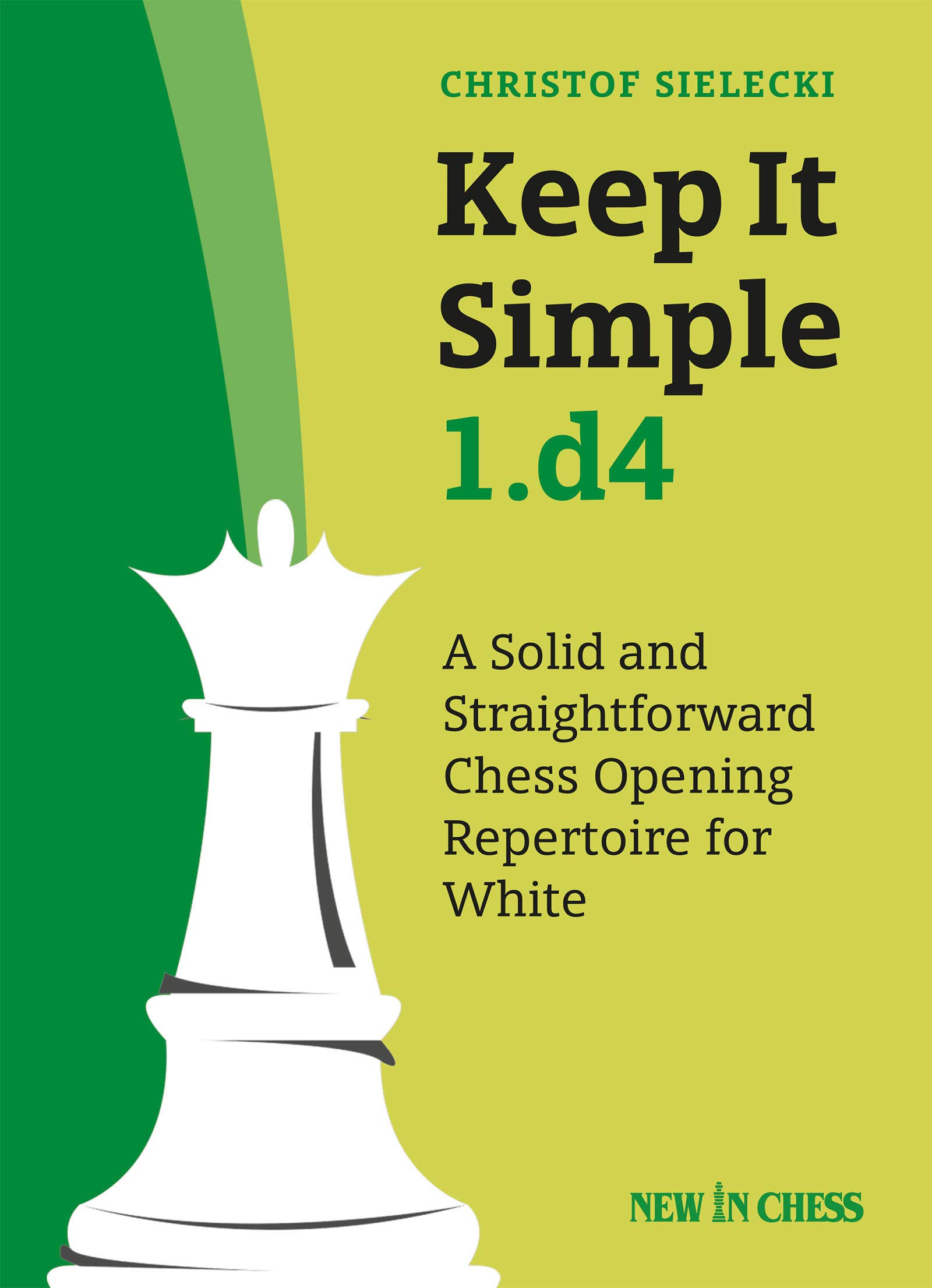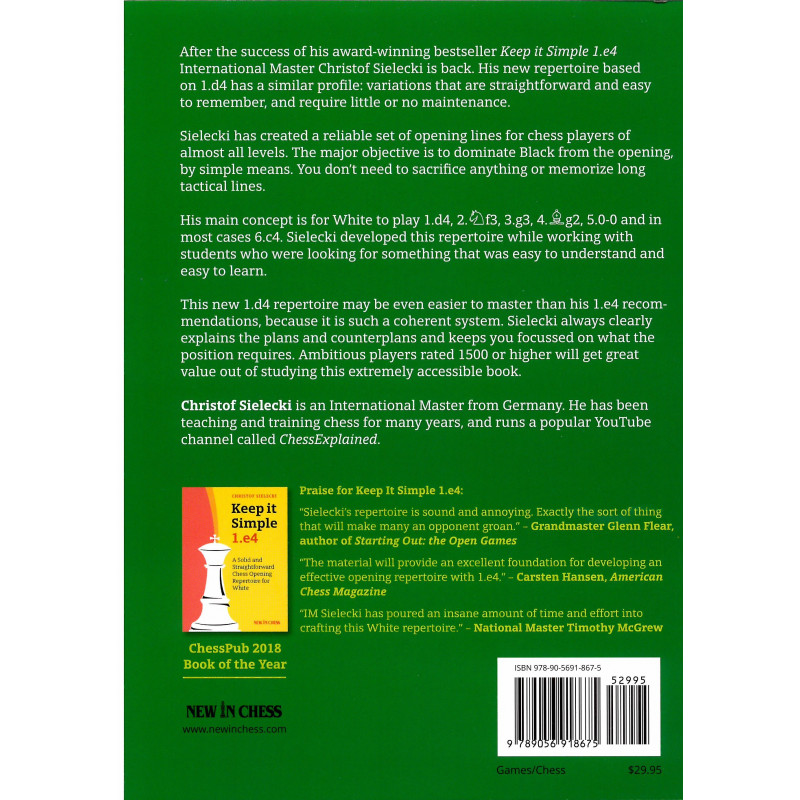Keep it Simple 1.d4 : Christof Sielecki

“Half the variations which are calculated in a tournament game turn out to be completely superfluous. Unfortunately, no one knows in advance which half..” – Jan Timman
The value for any practising chess player of a coherent opening repertoire when playing with the white pieces is key to success, enjoyment and efficient use of study time. Books with “Opening Repertoire” in the title are many and varied and we were intrigued to what the emphasis in this latest book from New in Chess would be.
From the books rear cover :
After the success of his award-winning book ‘Keep it Simple 1.e4’ International Master Christof Sielecki is back. His new repertoire based on 1.d4 has a similar profile: variations that are straightforward and easy to remember, and require little or no maintenance.
Sielecki has created a reliable set of opening lines for chess players of almost all levels. The major objective is to dominate Black from the opening, by simple means. You don’t need to sacrifice anything or memorize long tactical lines.
His main concept is for White to play 1.d4, 2.Nf3, 3.g3, 4.Bg2, 5.0-0 and in most cases 6.c4. Sielecki developed this repertoire while working with students who were looking for something that was easy to understand and easy to learn.
This new 1.d4 repertoire may be even easier to master than his 1.e4 recommendations, because it is such a coherent system. Sielecki always clearly explains the plans and counterplans and keeps you focused on what the position requires. Ambitious players rated 1500 or higher will get great value out of studying this extremely accessible book.

So, what is Keep it Simple 1.d4 about ?
This is a weighty (427 pages) tome advocating a repertoire for white based on a “delayed Catalan” development approach against almost any line that black chooses.
Originally the content was provided on the popular training site Chessable. Its popularity caused New in Chess to publish in paper format. See Chessable version
From the successful series by Boris Avrukh (and many others) we know that the conventional Catalan System (1.d4, 2.c4, 3.g3) is a highly respected opening system played at the very highest levels by the worlds top players. So, a normal Catalan would see
appear fairly promptly allowing Black various options that White might like to avoid.
By delaying c4 to say move 6 then White is denying Black some of these sharper continuations and maybe allowing White to focus more on middlegame plans rather than engaging in theoretical skirmishes at move 2, 3, 4, 5 or even.
This is the kind of opening philosophy that has encouraged the London System (and the Colle System before that) “pandemic” to dominate club chess : “We show a system that allows you to get your pieces onto sensible squares without allowing your opponent to distract you”. Of course this is a gross over simplification but many club players want an easy life !
So, something typical might be :
where White’s last move was 6.c4
which is covered in chapter 8 and 9 depending if Black captures on c4.
There is one major difference with the approach Sielecki suggests in that we get to a principled set-up via a slower move order.
The book is divided into four main parts as follows :
- Black’s classical / symmetrical set-ups : 1.d4 d5 2. Nf3
- Black’s …g7-g6 based set-ups : 1.d4 Nf6 2.Nf5 g6 3.g3
- Black’s flexible set-ups : 1.d4 Nf6 2.Nf3 e6 3.g3
- Black’s sharp and offbeat defences
The author states he has three “KIS” guidelines :
- The chosen lines are simple to learn;
- It must be possible to find your way if you forget your lines;
- Choose lines that may not be most critical, but uncomfortable for the opponent
All the usual (and many unusual) structures from Black are given a detailed treatment :
Chigorin, Tarrasch, Grunfeld, King’s Indian, various forms of Benoni, Modern, Queen’s Indian, Benko b5 ideas, Dutch, Old Indian, Wade Defence and other odds and ends.
An interesting comment we noted elsewhere was from IM John Donaldson : “A worthy follow-up with the author achieving the near impossible in carving out a cohesive repertoire based on 1.d4 2.Nf3 and 3.g3 against all but a handful of Black replies. The most amazing magic trick is how the author makes the Slav and Queens Gambit Accepted disappear – namely by adopting the sequence 1.d4 d5 2.Nf3 Nf6 3.g3. This reviewer gives two thumbs up for for Keep It Simple 1.d4. It is full of interesting variations and ideas for players rated 2200 on up who are looking for a positionally oriented repertoire that is not overly theoretical.”
and “As promised, the repertoire is simple, but not so simple that it is not of practical value. IM Sielecki has taken great pains to research the material carefully and package it into a repertoire that is relatively consistent throughout.”–Carsten Hansen “American Chess Magazine ”
and “I like this particular repertoire very much as it’s one which could probably hold the reader in good stead for many years to come. His introductions, conclusions and textual explanations are instructive and ones that a human can readily appreciate, learn from and understand. As I think that I should keep my advice ‘simple’, then I would say ‘just get it’!”–Glenn Flear, Grandmaster “Yearbook 134”
So, who what is the most suitable audience for this book ? We would say that a club player of 2000 plus who wishes to upgrade their white opening into a Queen’s Gambit style structure would enjoy the content. Maybe they have been playing the London, Colle, Stonewall or Veresov systems and want to progress their chess : this book is ideal for that upgrade. It is also good for those who play a conventional move order looking for a more positional repertoire.
As a bonus for the observant, this book provides material for those wishing to kick-off with 1.Nf3 although you will need to deal with 1.Nf3 c5 of course !
As with every recent New in Chess publication high quality paper is used and the printing is clear. The book can easily be laid flat next to the board and does not require weights to prevent it from “self-closing” (a particular bugbear of ours !). Each diagram is clear and the instructional text is (mostly !) typeset in two column format, which, we find, enables the reader to maintain their place easily. Figurine algebraic notation is used throughout and the diagrams are placed adjacent to the relevant text.
At the rear is the customary detailed Index of Variations and following that there is an Index of Players where the numbers refer to pages.
In summary this book provides a pragmatic and positional repertoire for White against most of the all the commonly encountered responses to 1.d4 and 2.Nf3, 3.g3 and an eventual c4. There is a host of interesting new and dangerous ideas that help you fight for the whole point with the white pieces : recommended !
John Upham, Cove, Hampshire, February 19th 2020

Book Details :
- Hardcover : 432 pages
- Publisher: New In Chess (1 Dec. 2019)
- Language: English
- ISBN-10: 9056918672
- ISBN-13: 978-9056918675
- Product Dimensions: 17.6 x 2.7 x 23.1 cm
Official web site of New in Chess

